Contract management is proving to be a very time-consuming element of the business, which facilitates the need for an efficient and automated contract management system.
What is contract management?
Contract administration or follow-up of contracts concluded with customers, suppliers, partners or employees. In contract management, the process of managing contract creation, execution and analysis to maximize operational and financial performance in an organization, all while reducing financial risk.
Why is contract management important?
71% of all companies fail to find 10% or more of their contracts each year
– Journal of Contract Management
Contracts are managed and followed up in many different ways, but typically we see that contracts are managed with several spreadsheets, in different departments, without an indication of where the contracts can be found. This constitutes a list of various challenges for proactive contract management and securing income, lack of follow-up of the company’s obligations and/or opportunities and leads to weak internal control and inefficient use of time.
9% of a company’s total annual turnover is lost every year
– World Commerce & Contracting
Imagine that you have changed the product or service offer and the prices. You spend many hours looking through excel files, file folders and binders for contracts that need to be reviewed before the renewal date. When you manually look through hundreds of contracts, you finally find the contract, but without signatures. You call the customer or supplier to get the final contract, but they tell you that already last week the contract was extended by another three years under the same conditions. That means you lose several hundred thousand in turnover or increased costs.
Find out more: Effective contract management in 2024
Good contract governance and management is a key factor. Has an overview and management of the company’s contracts, has simultaneous control over the company’s obligations and can proactively influence the company’s suppliers, customers and business relationships for the good of the company and its owners.
Download the ShareControl Contract Guide
Get insight into all the features that help you with professional contract management.
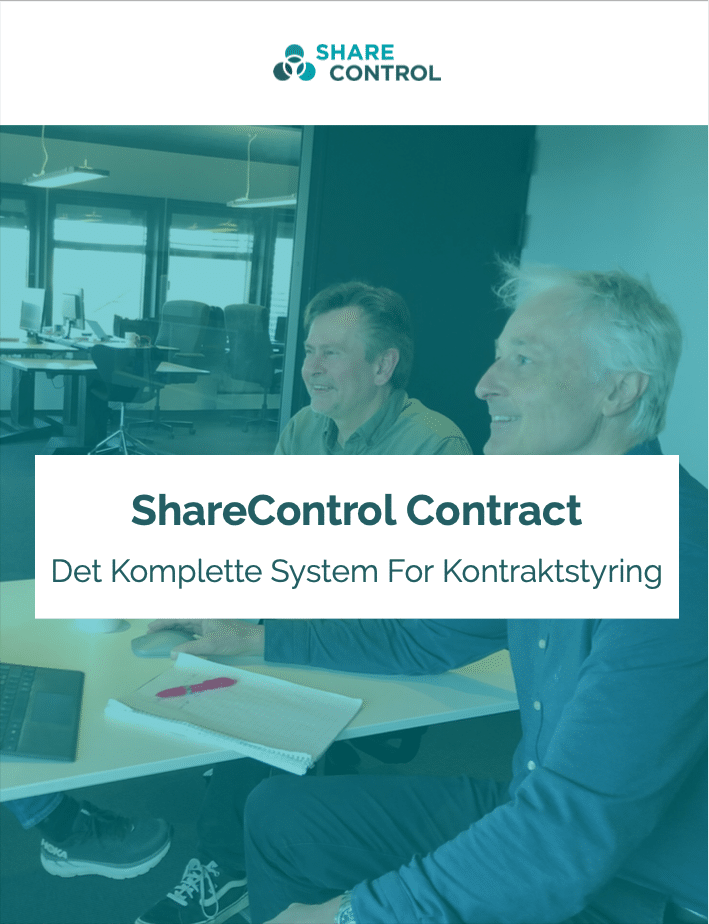
Typical contacts that most companies have
When we delve into the typical contracts that a company handles, it reveals a multitude of agreements that form the backbone of the business’ operations and success. Here is a glimpse of the different types of contracts that are often found in any organization:

IT equipment and licenses: From cloud-based servers to software licenses and computers, IT equipment and license contracts ensure that the organization has access to the necessary technology to support its operations.
Service agreements: Agreements for service deliveries that are essential to fulfilling the company’s obligations to customers, including janitorial services and facility maintenance, ensure flexible operational support.
Equipment rental/rental: From security systems to parking services, equipment leases cover a wide range of needs, including power and Internet services essential to modern businesses.
Leasing agreements: Whether it’s company cars or production equipment, leasing agreements provide a flexible approach to obtaining necessary resources without large capital investments.
For leases, Share Control also offers lease accounting systems according to IFR 16.
Supplier contracts: From insurance and accounting to legal assistance and marketing services, supplier contracts ensure continuity and quality in support services that are crucial to the business’s operations.
Employment and consultancy contracts: From employment agreements to pension schemes and health insurance, contracts relating to employees and consultants ensure that the company fulfills its obligations to the workforce.
Office Equipment: From office furniture to coffee machines, office equipment contracts ensure that the workplace is equipped for productivity and comfort.
Premises agreements: Leases for office premises and warehouses ensure that the company has suitable facilities to run the business.
These contracts represent fundamental agreements that are essential for maintaining efficient and sustainable operations in any organization. By handling them carefully and strategically, companies can ensure stability, continuity and progress.
How to achieve and facilitate successful contract management?
How to improve contract management successfully?
It doesn’t take a big business before you have many contracts and agreements you have to follow up. As the business grows, further complexity comes in that different business units, locations and employees at different levels have responsibility for follow-up and control.
It is therefore wise already at an early stage to ensure that you have good systems, with which the company can also grow further in order to manage the follow-up of contracts in an efficient manner.
Below we have set up 7 steps to facilitate good contract management.
Advantages of contract management
Good contract management is a key factor in good business operations. This ensures that the business gets an overview and management of the company’s contracts. With control over the company’s obligations, in addition to good control, one can influence the company’s suppliers, customers and business relations to the best of the company and its owners.
7 Contract Management Challenges and How to Solve Them
Navigating the landscape of contracts within any organization can be a daunting task, often fraught with challenges that require strategic solutions. Here we delve into seven key obstacles to contract management and explore effective ways to overcome them:
1 Get an overview of the scope
Get an overview of the company’s agreements and the number of contracts. Divide them into types/categories and assess whether each category of agreement has any common requirements for follow-up. An example could be tenancy agreements, where the rent amount must be updated according to kpi on October 1st each year. It can also be useful to indicate whether the agreement is critical to the company’s value creation with a high priority or whether the agreement has a low impact on the company’s operations. That way, you can set up metadata related to the agreement that can generate different focuses and follow-up.
2 Clarify responsibilities and powers
What we experience as failing is a lack of ownership and responsibility for following up the agreement and the agreement portfolio. This is in addition to the fact that employees have left and started without the responsibility for previously concluded agreements having been clarified. With responsibility also come powers and rights, such as amount limits, approval processes adapted to an organizational structure, as well as clarification on follow-up and updating of agreements and contracts.
3 Have contracts and agreements collected in a common place
The company’s agreements and contracts are often stored in different places. The first thing one should therefore do is to initiate a process to “capture” all the contracts and where they are archived or stored. It is then appropriate to collect and store all the contracts in place, in such a way that you get a good overview of the type of agreements and that the agreements can easily be found again.
4 Create routines and document the process for follow-up
Then create routines and activities for how the company will follow up on different types of agreements. Some agreements are automatically renewed, others are terminated after the end of the contract period. Other contracts contain options that must be assessed and/or activities and tasks that must be followed up. A lack of follow-up can result in large costs and loss of business for a business. It is therefore important to have a good system in place, so that the contract manager receives a notice in good time before the contract is renewed, expires, the price is to be adjusted, that an option is to be assessed or that other contractual obligations are to be exercised.
The notice should go to the employee and the role of the contract manager, as well as their superior if there is a lack of follow-up. One should also have systems that provide an overview of all contractual obligations and when they are due. That way, you can get effective direct follow-up, but at the same time be independent of staff in the event of illness, temporary absence or changes in the organization or personnel.
5 Good input of contractual obligations provides good cost control
A good overview of the contractual obligations and control over costs is established with good input and data capture. It is therefore important to enter data that can provide an overview of the future obligations (per month, quarter or year) and type of cost, so that good forecasts and data for budgeting and accounting can be obtained.
6 Good planning and use of data
It is important that an agreement system is easy to update, when employees leave, start, have leave or have other temporary periods of absence. The system should be such that one satisfies continuous changes in an organization without situations arising where certain contracts fall between “two chairs”
Another element is that the system should provide good opportunities to get an overview of how much one buys from different categories and from which suppliers. In this way, the system can provide data that can provide useful information in a future negotiation situation, e.g. by exploiting an advantage of scale by simultaneously reducing the number of suppliers.
7 Digitize and automate contract management and follow-up
A digitization of contract management and follow-up will give the company a saving in time, as well as cost control and better management of the company’s interests. Key words here are efficient preparation of new agreements, easy access to associated information, the possibility of easy sharing of content as part of finalizing a contract, the possibility of electronic signing, good notification of critical contract dates and, not least, the possibility of quickly searching for and find contracts and agreements.
Get a demo of ShareControl Contract
Contract Management Lifecycle
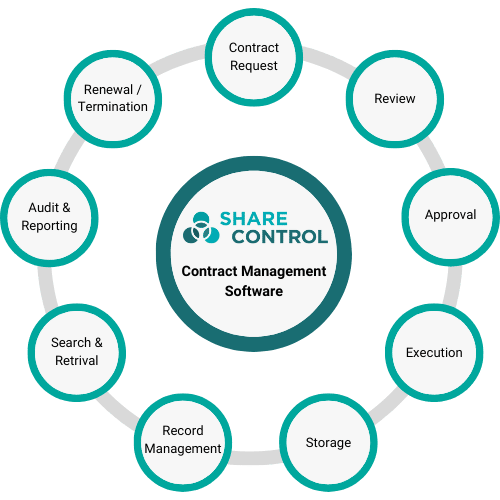
Creation of contract
Contract Life Cycle Management starts with the contract document. This is usually the first step in the Contract Life Cycle Management inquiry process where a party requests or initiates the contract process and then uses this information to prepare or write the contract. This is usually the first step in Contract Life Cycle Management.
| Input | Output |
|---|---|
| Information about what the contract should contain and critical dates such as the contract’s start date, end date and any milestones | Contract request information is stored in the CLM software system and is visible in the contract management dashboard for further CLM stages. Review and audit trail |
Contract negotiations and review
In the contract authoring or design stage, a contract or agreement document is created or generated using create a new or reuse a previous contact Share Control Contract Management that includes metadata, terms and conditions. It is usually at this stage that contract approvers and signatories are determined, and approver and signatory details are captured in the contract document.
Registration data adapted to needs:
Example of information about contractual partner. Image shows a screenshot from Share Control’s Contract Management in Microsoft 365.
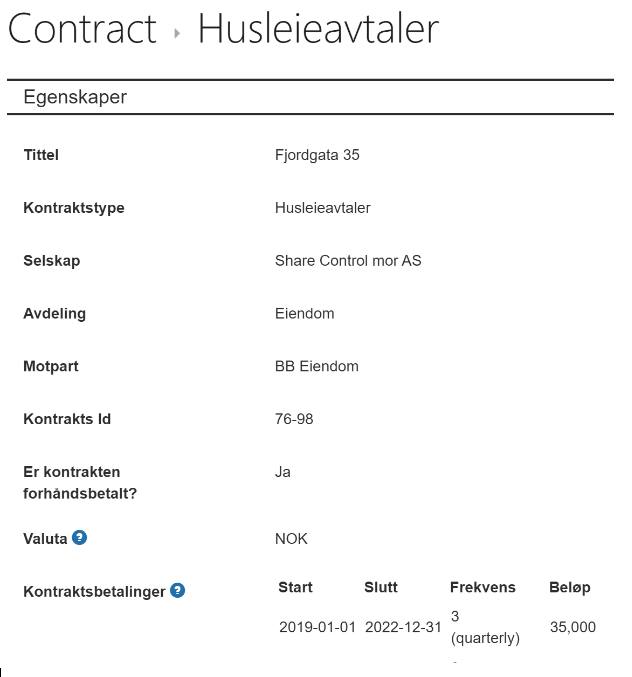
Related agreement and documents:
Examples of documents can be contracts or agreement documents, floor plans, email exchanges with the landlord, other documents and calculations usually in Microsoft Word or Adobe PDF format stored in the document management solution.
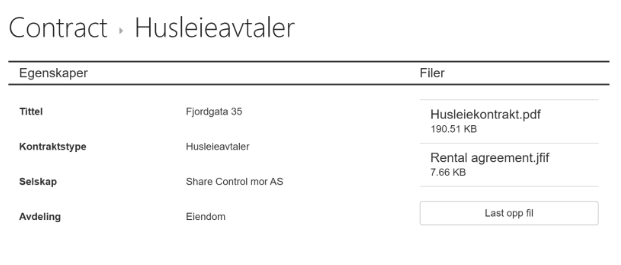
Contract approval and signing
Agreement document prepared in the previous step is sent to internal or external approvers, and as soon as they approve the document to proceed further, the contract document is moved to the next step in the CLM lifecycle.
The contract document is then sent to contract approvals and to designated stakeholders for review and comment.
Contract document that has been approved is sent to the respective parties for signature.
Example of contract document to be sent for signature using Adobe Sign or DocuSign:
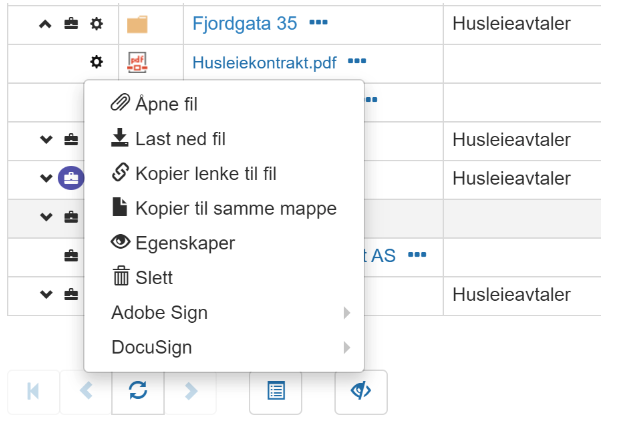
Obtaining contract
Once the contract document has been signed, it is permanently stored in the contract system where it is easy to retrieve. Both contractual metadata and documents are indexed and stored for future reference. This stage enables full control of all critical business documents through reliable record storage with backups and retention enforcement policies that provide confidence that your critical records are secure and compliant with GDPR and contract management system vendor data processing agreements.
Contract search and find
This stage enables business users to quickly search, apply filters and retrieve relevant documents from a contract system.
Contract management process and reporting
Each stage captures user activity logs and the contract metadata and documents are properly indexed for easy retrieval. This stage ensures that business users can quickly and efficiently retrieve and mine contract data and produce in-depth reports.
Reports
Custom reports should be used on an ongoing basis and can be a good help in keeping control of the company’s contractual obligations. Ad hoc reports are also useful, where you can make specific searches for contracts or types of contracts and be able to drill down to the specific contract with associated documentation.
Contract review and audit
When the contract reaches its end date, it must be renewed to remain in active status. If the contract is not renewed in time, it may entail financial risk for the parties involved in the contract.
Notification for renewals or other activities
The contract manager must be able to be notified of any renewals or activities that the contract has described. The notification can either be sent as an email and/or a task that the contract and activity manager must respond to and approve when the activity has been carried out.
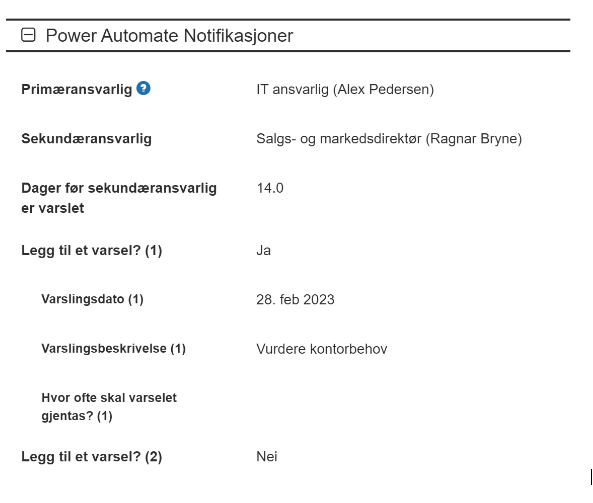
Renewal of a contract or termination
Contracts are inherrently individual. Some renew automatically, others require a renewal and still others have built-in options that must be notified whether or not to use them. It is therefore important that the contract manager sets notice periods, so that one has the opportunity to possibly renegotiate the agreement or set aside sufficient time to consider a termination or renewal of the contract.
Example of registration data:
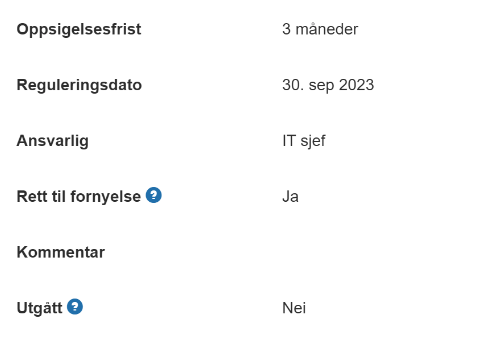
ShareControl Contract
System for Agreement Management & Contract Management
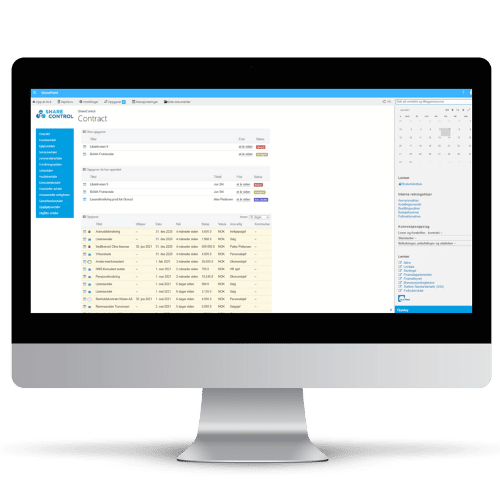
Activities that ensure good contract management
An agreement or contract between two or more parties is often to secure an acquisition or service. Good contract follow-up is necessary to ensure that the agreement is complied with according to what is to be delivered and that the business achieves the goals that have been set. Good contract follow-up also contributes to good cooperation with the parties to the agreement and averts possible conflicts as a result of misunderstandings.
Read more about implementing contract management here
Activities that ensure good contract management can be divided into 3 parts:
1 Implement the agreement in the business
Employees who are affected by the agreement should receive sufficient information about the agreement that has been entered into. The responsibility for follow-up should be clear to those affected in the business, including users of the agreement.
Recommended activities to ensure good internal implementation:
- Start-up meeting with supplier
- Make the agreement known
- Give users access to information
2 Using the agreement
Especially in the case of framework agreements or major procurement agreements, it is important to have good routines for the use and follow-up of the agreement. It may be important to arrange for good ordering routines and feedback should any deviations occur.
3 Manage the agreement
Administration of the agreement involves good follow-up and interaction with the main supplier adapted to the agreement’s content and scope. A regular review and assessment of the delivery against the need is recommended. With a good contract system, you can simplify the work of following up the contracts and secure the company’s business interests.






